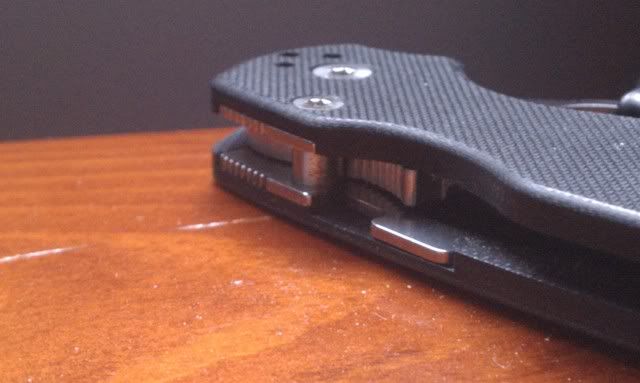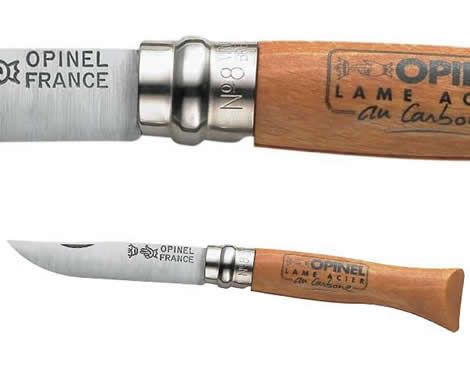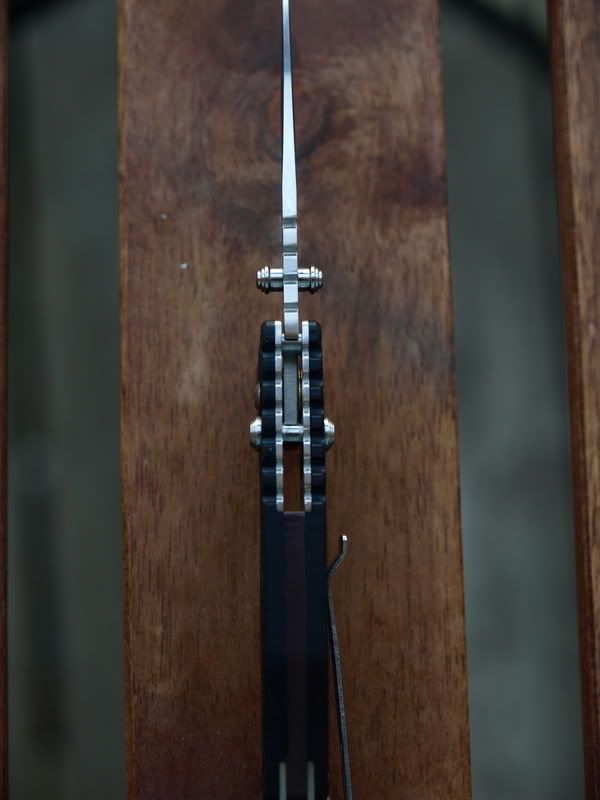Hey all, since I've got some time over the next month or so, I thought I'd start writing up a primer on knives (as it seems to be a pretty popular topic 'round these parts). This primer will be in multiple sections and I'll do my best to find useful diagrams and pictures to illustrate points. Alright? Let's get started.
Part 1: Types and Styles of Knives
Before we get started, just a little bit of vocabulary:
Tang: When you use the word "tang" with a knife, it generally means the unsharpened portion of the knife that extends beyond the sharpened blade area.
Fixed Blade Knives:
Fixed blade knives are just what the title would suggest. The knife is a single piece, generally a piece of steel with either a partial or full tang. Fixed blades are stronger than folding knives, but are generally heavier and larger. They're used when in the following cases:
1. Absolute strength is paramount (such as in a survival knife)
2. Portability or weight concerns are not an issue. (such as in a chef's knife)
3. Speed and simplicity of access is important for self-defense (such as in a soldier's or policeman's fighting knife)
There are two main styles of fixed blade knives.
Full-Tang Knives
When a fixed blade knife has a single piece of steel that extends from the tip of the blade all the way to end of the handle, it is considered to have a "full tang". Full tang fixed blade knives are the strongest type of knife, but also the heaviest and most expensive to produce. A classic example of a full tang knife is the Ka-Bar USMC Fighting knife, a soldier's knife designed for World War 2 and sold to this day.
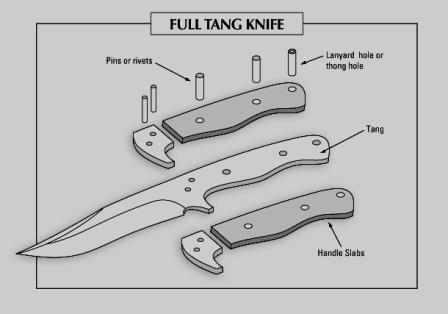
Example of a full-tang knife, courtesy of cgrif42
Partial or Hidden Tang Knife
A fixed blade knife is considered to have a partial or "hidden" tang when the blade tang does not extend all the way to the end of the handle. This is generally a weight-saving measure, but also makes the knife less expensive to produce. Mora survival knives from Sweden tend to have partial tangs.
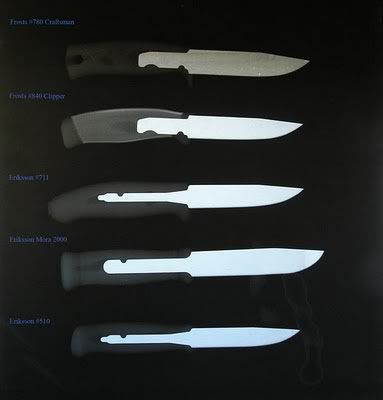
Xray of various Mora knives showing the partial tang. Courtesy of wordtrekker.blogspot.com
Folding Knives
Folding knives come in many different shapes and forms, but the common thread to all of them is this: Folding knives generally have a hinge or pivot system that allows the blade to somehow fold in to the handle. How this hinge is executed and how the knife is kept from collapsing when deployed is handled in any number of ways.
The major advantage that folding knives have over fixed blade knives is that of blade size: for a given weight and length, a folding knife can carry a much larger blade than a comparable fixed blade knife. The major detriment to folding knives over fixed blade knives is that they cannot be as strong as a fixed blade knife due to physical restraints.
Generally folding knives are used in the following situations:
1. Where weight or size are of a paramount concern (hiking, camping, general soldier duty knives)
2. Where absolute strength is not required (every day usage or utility knives)
3. Issues of legal restraints (fixed blade knives are often automatically considered offensive weapons)
There are many different types of folding knives, so I'm just going to go over the basic types here.
Slip Joint Knife
The most common, best selling and most popular type of folding knife is the slip joint knife. The slip joint knife uses a piece of spring steel on the back of the knife that rests on a flattened portion of the blade tang to provide some resistance to closure during use. Slip joint knives do not employ a locking mechanism of any type, and enough pressure on the top of the blade is enough to close it.
In countries that have legal issues surrounding locking blade knives, slip joint knives are often a legal alternative (the UK and Germany are classic examples).
The vast majority of Swiss Army Knives made by Victorinox/Wenger are of the slip joint style, and it is a classic style of working knife made the world over. Some famous slip joint knife makers include Sheffield Tools, Schrade Cutlery, Queen Cutley, Case XX, Victorinox/Wenger, Taylor's Eye Witness and many others.
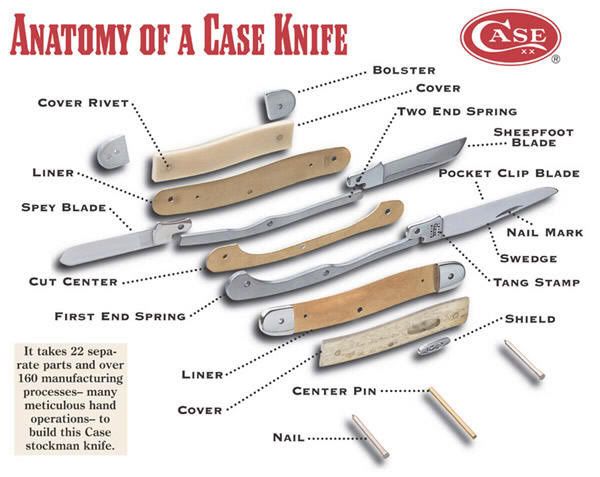
An exploded view of a multi-blade slipjoint Case Knife, courtesy of Custom Tacticals.
Lock Blade Knife
As the name would imply, a lock blade knife employes a locking mechanism when opened to prevent closure of the knife during usage. This requires a secondary step by the user to close the blade, and exists to prevent accidents under heavy usage. It should be noted that there are no blade locks proven to be immune to failure under heavy usage. There are a very large number of different locking mechanisms currently available on the market today, and as such I'll be dedicating a full article on them alone. Some classic lock styles include the collar lock, back or spine lock, liner lock, frame lock and axis lock.
The classic example and probably best known locking knife is the Buck 110 Folding Hunter. This knife employs a back lock.
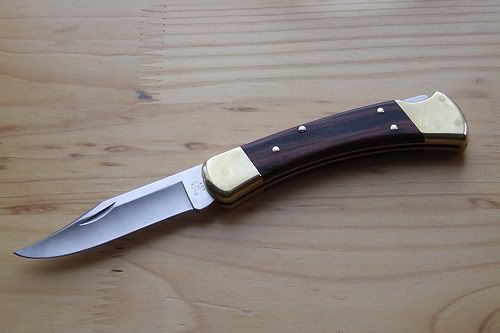
Buck 110 Folding Hunter showing the back lock. Courtesy of Waka Waka
There are three subsets of locking knives to be aware of:
1. Two Handed Opening (THO): As the title implies, this type of folding locking knife requires two hands to open. The Buck 110 pictured above is a THO knife.
2. One Handed Opening (OHO): As the title implies, this type of knife can be opened with one hand, utilizing a thumb disk, thumb stud, flipper tang or hole in the blade. Spyderco is generally credited with creating the first production OHO pocket knife.
3. Assisted Opening Knife: This knife employs a spring or torsion bar to provide an assist to the opening of the knife. This style of knife differs from a switchblade in that the opening mechanism is attached to the blade, rather than a button or switch on the handle. This is an important legal distinction in many place.
Friction Folders
A somewhat rarer type of folding knife, the friction folder uses neither a back spring or a locking mechanism to keep the blade open. Instead, the friction of the handle halves around the back of the blade keep the blade open. Friction folders often have an extended tang "spoon" that goes under the palm when the knife is open, providing extra security. Many traditional folding knives are a type of friction folder - these include the New Zealand Peasant Svord, the French Douk-Douk and the Japanese Higonokami.

A peasant Svord knife, showing the extended tang "spoon". Picture courtesy of Dirty Bob of the EDCForums.com
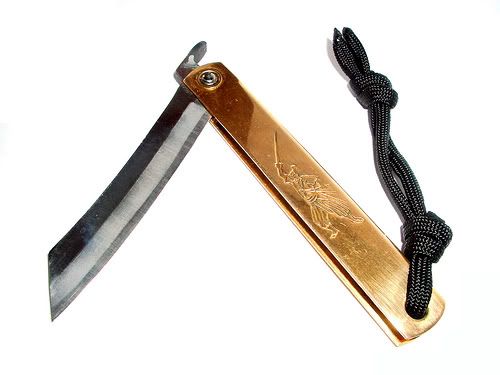
A traditional Higonokami, showing a smaller tang "spoon". Picture courtesy of Alexander Blecker.
The Balisong or Butterfly Knife
Featured in many films of the 80s and 90s as a gang knife, the Balisong (or butterfly knife) of the Phillipines is in fact one of the first true one handed opening pocket knives ever created. The balisong is unique among folding knives in that instead of a blade being attached to the handle via a single pivot, the handle is split in half and swings freely on two pivots. The handles can be folded forward to protect the blade, or folded back to create the knife handle. This particular system is 100% stable against folding during use, but it should be noted that this style of folding knife, like all others, can fail on heavy usage. The failure point in this case is the pivot between handle and knife. Generally used as a self-defense/weapon knife in North America, the balisong is an every day usage knife in it's native Phillipines.
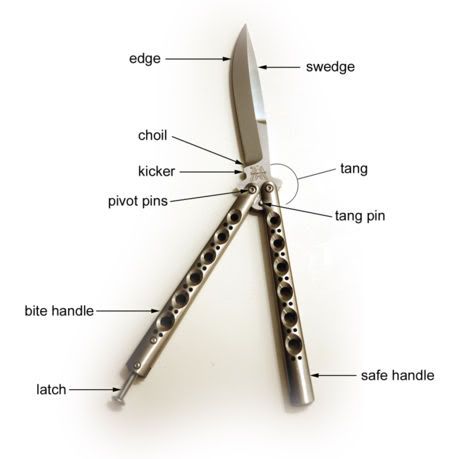
The traditional Balisong, picture courtesy of www.varietyartsclubdirectory.com
Switchblades and Automatic Knives
The last major category of folding knife is that of the switchblade or automatic knife. Generally when one thinks of a switchblade, the first image is that of the classic Italian stilleto switchblade - very thin, with a button on the handle that shoots the blade out of the front. In North America, this particular knife is the iconic 50s "greaser" knife, replaced in movies and TV shows with a switchblade comb.
However, there is much more to know about this particular style of knife. Legally, the category of switchblades and automatic knives includes any knife that uses a spring or torsion bar to provide an opening assistance mechanism, and said mechanism is actuated by a switch or button not attached to the knife blade. This switch or button is generally attached to the knife handle instead. This is different compared to the assisted locking knife, which uses a spring or torsion bar for opening assistance, but the opening mechanism is attached to the knife blade, either through an extended flipper tang or with the thumbstud. This distinction is very important as it forms the legal difference between assisted opening knives (which are generally legal in most parts of North America and other Western nations), and switchblades or automatic knives (which are generally not legal for the public).
Button-actuation automatic knives find most widespread use in either military or law enforcement hands in North America. Considered a close-quarters weapon of last resort, the automatic knife is considered an excellent "under duress" knife as the button actuation is extremely simple, even under stress. The largest maker of military-grade automatic knives is Microtech knives.
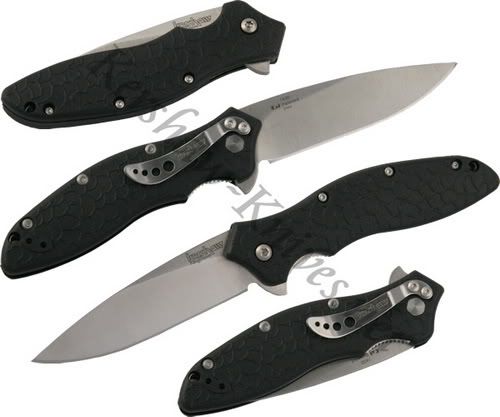
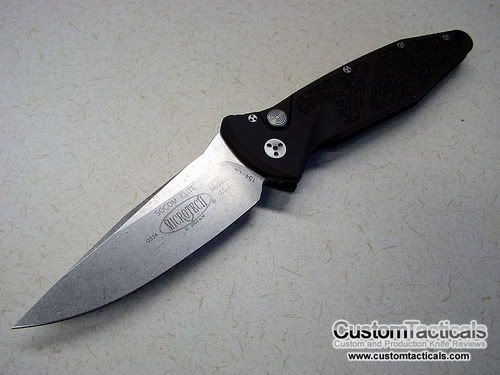
For comparison's sake, we have on the top the Kershaw OSO sweet, and on the bottom, the Microtech Socom Elite Military Automatic knife. When closed, the extended "flipper" tang on the Kershaw OSO sweet is plainy visible sticking up through the top of the handle. This is the feature that puts the Kershaw in to the assisted knife category, an importang legal distinction. On the right, we can clearly see the actuation button on the handle of the Microtech knife, which categorizes it as an automatic knife. Pictures courtesy of kershaw-knives.net and CustomTacticals.com.
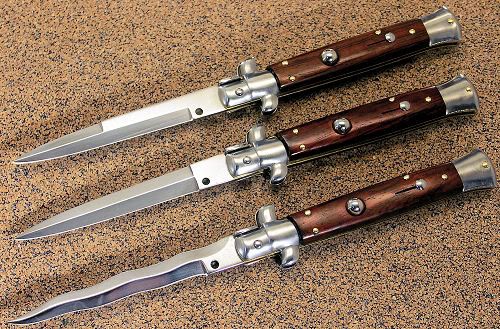
A picture of a classic Italian stilleto-style switchblade. Note the button on the handle used for actuation. Picture courtesy of nicnac.net
Here ends primer section number 1 on pocket knives. Next week: Locks!
